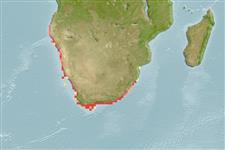>
Mugiliformes (Mullets) >
Mugilidae (Mullets)
Etymology: Chelon: Greek, chelone = turtle (Ref. 45335).
Eponymy: Sir John Richardson (1787–1865) was a Scottish naval surgeon, naturalist and Arctic explorer. [...] (Ref. 128868), visit book page.
Environment: milieu / Zona climática / intervalo de profundidade / distribution range
Ecologia
marinhas; Água doce; estuarina demersal; catádromo (Ref. 46888). Subtropical; 16°S - 36°S
Southeast Atlantic: South African coastal waters from Walfish Bay to Natal.
Comprimento de primeira maturação / Tamanho / Peso / Idade
Maturidade: Lm 25.0 range ? - ? cm
Max length : 40.5 cm TL macho/indeterminado; (Ref. 3573); common length : 30.0 cm TL macho/indeterminado; (Ref. 2830)
Espinhos dorsais (total) : 5; Raios dorsais (total) : 8 - 9; Espinhos anais: 3; Raios anais : 9.
Body shape (shape guide): fusiform / normal.
Found in coastal waters, mainly off rocky points and sandy beaches; may enter estuaries which serve as nursery areas (Ref. 27121). Feed mainly on diatoms and detritus, but also on planktonic crustaceans (Ref. 27121). Oviparous, eggs are pelagic and non-adhesive (Ref. 205). A primary target species of the inshore net fishery and much of it is sold salted and dried and known as 'bokkoms'. It is also an important exhibit species in public aquaria in South Africa. It is parasitised by the monogenean Gyrodactylus molweni on the external body surface (Ref. 124050).
Ciclo de vida ou comportamento de acasalamento
Maturidade | Reprodução | Desova | Ovos | Fecundidade | Larvas
Smith, M.M. and J.L.B. Smith, 1986. Mugilidae. p. 714-720. In M.M. Smith and P.C. Heemstra (eds.) Smiths' sea fishes. Springer-Verlag, Berlin. (Ref. 4393)
Status na Lista Vermelha da UICN (Ref. 130435: Version 2025-1)
Ameaça para os humanos
Harmless
Uso pelos humanos
Pescarias: espécies comerciais; Aquário: Aquários públicos
Ferramentas
Relatórios especiais
Baixar XML
Fontes da internet
Estimates based on models
Preferred temperature (Ref.
123201): 14.8 - 27, mean 24.8 °C (based on 56 cells).
Índice de diversidade filogenética (Ref.
82804): PD
50 = 0.5010 [Uniqueness, from 0.5 = low to 2.0 = high].
Bayesian length-weight: a=0.01096 (0.00599 - 0.02007), b=2.95 (2.80 - 3.10), in cm total length, based on LWR estimates for this species & Genus-body shape (Ref.
93245).
Nível Trófico (Ref.
69278): 2.4 ±0.16 se; based on food items.
Resiliência (Ref.
120179): médio(a), tempo mínimo de duplicação da população 1,4 - 4,4 anos (Preliminary K or Fecundity.).
Fishing Vulnerability (Ref.
59153): Low to moderate vulnerability (31 of 100).
🛈
Nutrients (Ref.
124155): Calcium = 53.2 [14.2, 311.9] mg/100g; Iron = 0.741 [0.382, 1.308] mg/100g; Protein = 18.2 [16.8, 19.7] %; Omega3 = 0.681 [0.307, 1.551] g/100g; Selenium = 7.2 [3.0, 17.9] μg/100g; VitaminA = 11.3 [3.4, 37.6] μg/100g; Zinc = 0.691 [0.433, 1.097] mg/100g (wet weight);
